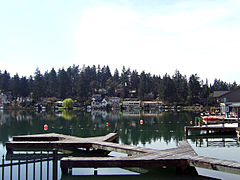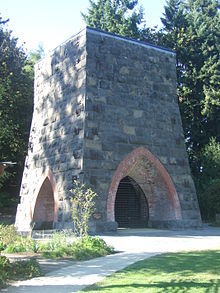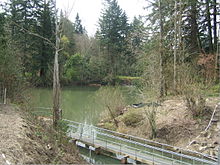- Oswego Lake
-
Not to be confused with Lake Oswego, Oregon.
Oswego Lake 
Lakewood Bay (connected to the main lake in 1928) Location Lake Oswego, Clackamas County, Oregon Coordinates 45°24′34″N 122°41′47″W / 45.40944°N 122.69639°WCoordinates: 45°24′34″N 122°41′47″W / 45.40944°N 122.69639°W Lake type Kolk depression/Reservoir Primary inflows Tualatin River, Springbrook Creek Primary outflows Willamette River (via Oswego Creek) Catchment area 6.6 mi (10.6 km)[1] Basin countries United States Max. length 2.5 mi (4.0 km) Max. width 0.3 mi (0.48 km) Surface area 395 acres (1.60 km2)[1] Average depth 26 ft (7.9 m)[1] Max. depth 55 ft (17 m)[1] Water volume 10,055 acre·ft (12,403,000 m3)[1] Residence time 2 months[1] Shore length1 10.6 mi (17.1 km)[1] Surface elevation 99 ft (30 m)[1] Islands Jantzen Island Settlements Lake Oswego 1 Shore length is not a well-defined measure. Oswego Lake is a privately owned lake in Clackamas County, Oregon that is completely surrounded by the city of Lake Oswego. Though the lake is naturally occurring (a former channel of the Tualatin River), it is considered a reservoir because of the concrete dam that has increased its size to 395 acres (1.60 km2).
Contents
Geologic history
The lake is a former channel of the Tualatin River, carved in basalt to the Willamette River. Eventually, the river changed course and abandoned the Oswego route.[1]
About 13,000 to 15,000 years ago, the ice dam that contained Glacial Lake Missoula ruptured, resulting in the Missoula Floods, which backed the Columbia River up the Willamette River. The flooding created an underwater vortex called a kolk, which scoured out and enlarged the old Oswego channel, creating a natural lake.[2] The rocks and boulders were flung by the kolk up to a mile away to present-day Durham and Tualatin, where they were quarried for many years before the site was converted to the Bridgeport Village shopping center.[1][3]
Early human habitation
The lake was known to the native Clackamas Indians as Waluga ("wild swan"), for the birds they hunted there. With the arrival of European settlers in the mid-19th century, the lake was called Sucker Lake for a type of fish that was abundant in its waters.[4] In 1847, Albert Alonzo Durham built a sawmill on on Sucker Creek, the lake's outlet to the Willamette River. In 1850, he made the first Donation Land Claim in the area, which he named Oswego after Oswego, New York.[5]
Iron industry
In 1865, the Oregon Iron Company was incorporated with the goal of making the town of Oswego an industrial center for the smelting of the abundant iron ore in the area. The company purchased the entire town of Oswego, including the lake and surrounding hills, which were rich in not only iron ore, but trees that would be turned into charcoal to feed the furnaces.[6] Population in the town boomed, aided by the opening of a narrow gauge railroad from Portland in 1886. The Oregon iron industry peaked in 1890, but with the availability of cheaper coke-fired iron and steel mills, by the early 20th century it had nearly collapsed.[5]
Lake expansion
In 1872, a canal was completed that connected the lake to the Tualatin River, allowing steamships from the Tualatin River and Navigation Company to travel on the lake.[7]
A series of wooden dams had been built at the outlet to Sucker Creek beginning in 1860 to provide water power; but since winter floods would wash out these dams within a few years, in 1921 a concrete dam was built, which not only provided a more reliable power source, but also allowed the lake level to be precisely controlled. The level was allowed to rise several feet to cover the unsightly stumps left over from logging and create a more visually appealing shoreline.[8]
With the name Sucker Lake considered unappealing to potential residents, the community decided to rename the lake. While "Lake Tualatin" was considered, in 1913 the United States Board on Geographic Names officially renamed it Oswego Lake.[9]
In 1928, a marshy area known as the Duck Pond adjacent to the lake was flooded, and a canal dug to it to connect to the main lake to create Lakewood Bay, which allowed more shoreline homes to be built next to the newly completed Pacific Highway (now part of Oregon Route 43).[10]
Land development
With the demise of the iron industry, the now-renamed Oregon Iron & Steel Company turned to development of its approximately 23,000 acres (93 km2) of land surrounding the lake. The company built a power plant in 1909, just before the incorporation of the City of Oswego in 1910. Headed by Oregon Iron & Steel president William M. Ladd (son of former Portland mayor William S. Ladd, who was one of the original investors in the Oregon Iron Company), the Ladd Estate Company converted the iron town into a prestigious lakeside retreat.[6]
In 1924, Paul Murphy developed the Oswego Lake Country Club to promote Oswego as a place to "live where you play."[5] The Paul Murphy Company replaced Ladd's company as developer of Oregon Iron and Steel's property in 1940, and the following year, Oregon Iron and Steel created the Lake Oswego Corporation, which still owns the lake as a private corporation of lakefront property owners.[9] In 1960, shortly before ending its existence, Oregon Iron & Steel was disbanding deeded the powerhouse and dams to the corporation.[9]
Modern history
Today, the lake is still owned by the shareholders of the Lake Oswego Corporation, who typically become shareholders upon purchasing property along the lakefront. There are 690 lakefront property owners, and another 515 families who belong to one of 20 waterfront easement associations.[11] The Corporation manages property easements, lake access, boat and operator licensing, water safety and water quality, and lakefront building permits.[12] There is no public access to the lake, although residents of Lake Oswego who are not shareholders have access to one public swim park, and families in the Lake Oswego School District have access to another.[11] Periodically, the Corporation lowers the water level in the lake by opening the dam to allowing water to enable lakefront property owners to conduct repairs on docks and boathouses.[13] In 2010, the lake was lowered approximately 24 feet (7.3 m) to allow for construction of a new sewer line, the lowest lake level since 1962 when the original sewer line was installed.[14]
With the relative scarcity of building easements, lakefront property is considered prestigious, and a number of architecturally significant homes have been built along its shores, including the Carl C. Jantzen Estate, a Tudor-style estate on the National Register of Historic Places, built on an island on the lake's north shore by the founder of the Jantzen swimwear company in 1930. In addition, the lakeshore features homes by noted Portland architects such as Richard Sundeleaf and Van Evera Bailey.[15]
Lake health
In recent years, the lake has experienced explosive algae growth in the lake, due in part to runoff from lawn fertilizer, which is rich in phosphorus. The Lake Oswego Corporation has been criticized for its slow response in addressing the problem.[11] In September 2010, the lake was drawn down to allow replacement of an aging sewer pipe that traverses the lake. The lake was refilled to its usual level in the summer of 2011.[16]
Notes
- ^ a b c d e f g h i j Johnson, Daniel M. (June 1985). Atlas of Oregon Lakes. Oregon State University Press. p. 114. ISBN 0870713434. http://aol.research.pdx.edu/atlas_pages/AOL_110.pdf.
- ^ Stephens, Patia (Winter 2001). "Sedimental Journey". The Montanan. University of Montana. http://www.umt.edu/montanan/w0102/sedimental.html. Retrieved 2008-04-02.
- ^ "Oswego (Sucker) Lake, Lake Oswego, Oregon Waymark". Waymarking.com. http://www.waymarking.com/waymarks/WM16KA. Retrieved 2008-04-02.
- ^ Fulton, p. 15
- ^ a b c "A Brief History". City of Lake Oswego. http://www.ci.oswego.or.us/about-lo/history.htm. Retrieved 2008-04-02.
- ^ a b Kuo, Susanna Campbell. "A Brief History of the Oregon Iron Industry". Oswego Heritage Council. http://www.oswegoheritage.org/history/pdf/history.pdf. Retrieved 2008-04-02.
- ^ Fulton, p. 33
- ^ Fulton, p. 80
- ^ a b c "Eight Myths Concerning Lake Oswego". Oswego Heritage Council. http://www.oswegoheritage.org/history/mythsmuddles.html. Retrieved 2008-04-02.
- ^ Fulton, p. 83
- ^ a b c Jaquiss, Nigel (2005-04-27). "Lake O-be-gone". Willamette Week. http://wweek.com/editorial/3125/6253/. Retrieved 2008-04-02.
- ^ "Other Links: Oswego Lake". City of Lake Oswego. http://www.ci.oswego.or.us/about-lo/links.htm#oswegolake. Retrieved 2008-04-02.
- ^ Tims, Dana (October 31, 2006). "Drawdown under way to lower Oswego Lake". The Oregonian.
- ^ Newell, Cliff (July 29, 2010). "Sewer project will make Oswego Lake disappear – briefly". The Oregonian. http://www.portlandtribune.com/news/story.php?story_id=128035388723593500. Retrieved October 4, 2010.
- ^ Goetze, Janet (February 2, 2008). "Big new homes lack grace of the past, says architect". The Oregonian. http://www.oregonlive.com/metrosouth/oregonian/index.ssf?/base/metro_southwest_news/1201848905172550.xml&coll=7. Retrieved 2008-04-02.
- ^ Newell, Cliff (June 2, 2011). "LOIS is flush with success". Lake Oswego Review. http://www.lakeoswegoreview.com/news/story.php?story_id=130696645456699100. Retrieved September 19, 2011.
References
Fulton, Ann (2002). Iron, Wood & Water: An Illustrated History of Lake Oswego. San Antonio, Texas: Historical Publishing Network and the Oswego Heritage Council. ISBN 1893619265.
External links
Categories:- Reservoirs in Oregon
- Lake Oswego, Oregon
- Tualatin River
- Willamette River
- Landforms of Clackamas County, Oregon
- Buildings and structures in Clackamas County, Oregon
Wikimedia Foundation. 2010.




